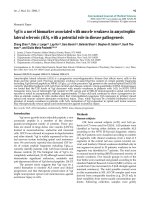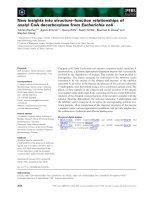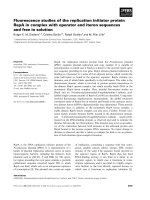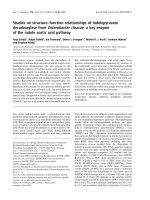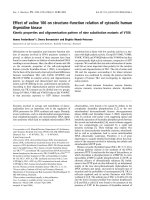Structure function studies of vesicle associated membrane protein associated protein b (VAPB) associated with amyotrophic lateral sclerosis (ALS
Bạn đang xem bản rút gọn của tài liệu. Xem và tải ngay bản đầy đủ của tài liệu tại đây (4.12 MB, 102 trang )
STRUCTURE AND FUNCTION STUDIES OF
VESICLE-ASSOCIATED MEMBRANE PROTEINASSOCIATED PROTEIN B ASSOCIATED WITH
AMYOTROPHIC LATERAL SCLEROSIS
Lua Shixiong
NATIONAL UNIVERSITY OF SINGAPORE
2011/2012
STRUCTURE AND FUNCTION STUDIES OF
VESICLE-ASSOCIATED MEMBRANE
PROTEIN-ASSOCIATED PROTEIN B
ASSOCIATED WITH AMYOTROPHIC
LATERAL SCLEROSIS
Lua Shixiong
B.Sc. (Hons.), NUS
A THESIS SUBMITTED FOR
THE DEGREE OF MASTER OF SCIENCE
DEPARTMENT OF BIOLOGICAL SCIENCES
NATIONAL UNIVERSITY OF SINGAPORE
2011/2012
ACKNOWLEDGMENTS
I would like to take this opportunity to express my deep sense of gratitude and
appreciation to my thesis supervisor, A/P Song Jianxing. He has been immensely kind
and forgiving towards me. His work on protein folding and discovery that pure water
could dissolve virtually all insoluble proteins had also made a huge impact on my
research interest.
During my studies, I had the privilege to interact with several marvelous people in
the structural biology lab, NUS DBS. I would like to thank my benefactor, Dr Shi Jiahai
for his kind help and advices. He was my mentor for several years and I’m immensely
grateful for that. I would also like to extend my gratitude to Dr Fan Qingsong who taught
me how to operate the NMR machine; Miss Ng Hui Qi for her help with protein
expression and ITC experiments; Mr. Lim Liang Zhong for his help with maintaining the
workstation and advice on molecular dynamics (MD) simulations; and Mdm. Qin Haina
for her help with fitting chemical shift deviations.
I would like to thank my parents, Mr Lua Guan Swee and Mdm. Lau Poh Eng for
their support and encouragements during my study.
i
SUMMARY
The process of protein folding is remarkably efficient, but sometimes it can go
wrong. This can have harmful consequences, as the incorrect folding of proteins is
thought to be the cause of diseases. Amyotrophic lateral sclerosis 8 (ALS8) caused by
the missense Thr46Ile and Pro56Ser mutation in the MSP domain of Vesicle-associated
membrane protein-associated protein B (VAPB) is one example of such “ misfolding
diseases”, and also the main focus of my research. In this thesis, the first structural
investigation on both wild-type, Thr46Ile and Pro56Ser mutated MSP domains is
presented.
The results revealed that the wild-type MSP domain is well-folded at neutral pH
but can undergo acid-induced unfolding reversibly. It has thermodynamic stability energy
(G0N-U) of 7.40kcal/mol and is also active in binding to a Nir2 peptide with a K d of
0.65μM. Further determination of its crystal structure reveals that it adopts a sevenstranded immunoglobulin-like β sandwich.
By contrast, the Pro56Ser mutation renders the MSP domain to be insoluble in
buffer. Nevertheless, as facilitated by the discovery that “insoluble proteins” can be
solubilized in salt-free water (Li et al., 2006), we have successfully characterized the
residue-specific conformation of the Pro56Ser mutant by CD and heteronuclear NMR
spectroscopy. Surprisingly, the Pro56Ser mutant remains highly-unstructured under
various conditions, lacking of tight tertiary packing and well-formed secondary structure,
only with non-native helical conformation weakly-populated over the sequence. As such,
the abolishment of native MSP structure consequently leads to aggregation and loss of
functions under the physiological condition.
ii
Unexpectedly, unlike the Pro56Ser MSP domain mutant, the Thr46Ile mutation
did not eliminate the native secondary and tertiary structures, as demonstrated by its farUV CD spectrum, as well as Cα and Cβ NMR chemical shifts. However, the Thr46Ile
mutation did result in a reduced thermodynamic stability and loss of the cooperative ureaunfolding transition which consequently causes it to be prone to aggregation at high
protein concentrations and temperatures in vitro. The same mutation also causes a 3 fold
reduction in its ability to bind to the Nir2 peptide and significantly eliminate its ability to
bind to EphA4. We have also provided evidence that the EphA4 and Nir2 peptide appear
to have overlapped binding interfaces on the MSP domain, which strongly implies that
two signalling networks may have a functional interplay in vivo.
Our study provides the first molecular basis for understanding the Pro56Ser and
Thr46Ile ALS-causing mutations. We have also shown that by introducing additional
Proline residues in the right context, the MSP domain could gain resistant to the Pro56Ser
mutation. Lastly, we hypothesized that the interplay of two signalling networks mediated
by the FFAT-containing proteins and Eph receptors respectively may play a key role in
ALS pathogenesis.
iii
TABLE OF CONTENTS
Acknowledgements
i
Summary
ii
List of Tables
vii
List of Figures
viii
Notations and Abbreviations
ix
Chapter 1
Introduction
1
1.1
Protein Folding Diseases
2
1.2
What is Amyotrophic Lateral Sclerosis?
3
1.2.1
Disease forms – Sporadic and Familiar ALS
3
1.2.2
Genetic risk factors
4
1.2.3
Environment risk factors
5
The human VAP (hVAP) family of proteins
5
1.3.1
Expression and subcellular localization
7
1.3.2
Domain of hVAPs
8
1.3.2.1
The MSP domain
8
1.3.2.2
The Coiled-coil domain
10
1.3.2.3
The TM domain
10
1.3.3
Cellular functions of hVAPs
11
1.3.3.1
Interactions with FFAT-motif containing proteins
11
1.3.3.2
Involvement of VAPB in the Unfolded Folded Protein Response
14
1.3.3.2.1
The Unfolded Protein Response (UPR)
14
1.3.3.2.2
VAPB is involved in the activation of UPR
16
1.3.3.3
Interaction with Eph Receptors
17
ALS8-causing mutations in VAPB
18
1.4.1
Functional consequences of mutations
20
1.4.2
Functional consequences of mutations
23
1.5
A challenge to study misfolded proteins
26
1.6
Objectives
27
1.3
1.4
iv
Chapter 2
Methods and Materials
28
2.1
Cloning of the MSP domain of hVAPs
29
2.2
Site directed mutagenesis
30
2.3
Expression of Recombinant protein
31
2.4
Extraction
31
2.5
Purification under the native condition
31
2.6
Purification under the denaturing condition
33
2.7
Isotope labeling
34
2.8
Purification of peptide used in binding assay
34
2.9
Measurement of protein concentration
34
2.10
Circular dichroism (CD) spectroscopy
35
2.11
Urea unfolding
35
2.12
ITC characterization of binding activity
36
2.13
NMR spectroscopy
36
Chapter 3
Studies on wt-VAPB, VAPB (P56S) and VAPB (T46I)
38
3.1
Studies on the wt-VAPB MSP domain
39
3.1.1
Structural properties of the wt-VAPB MSP domain
39
3.1.2
Stability of the wt-VAPB MSP domain
41
3.1.3
Binding activity of the wt-VAPB MSP domain
41
3.1.4
Crystal structure of the wt-VAPB MSP domain
42
Studies on the Pro56Ser mutation
44
3.2.1
Structural consequence of the Pro56Ser mutation
44
3.2.2
Residue specific conformational properties of VAPB (P56S)
46
3.2.3
Binding activity of VAPB (P56S)
49
3.2.4
Structural consequence of the Pro56Ser mutation
49
Studies on the Thr46Ile mutation
50
3.3.1
Structural consequence of the Thr46Ile mutation
52
3.3.2
Residue specific conformational properties of VAPB (T46I)
52
3.3.3
Stability of VAPB (T46I) MSP domain
54
3.3.4
Binding activity of VAPB (T46I) MSP domain
56
3.2
3.3
v
3.3.5
Interactions of VAPB MSP domain with the EphA4 receptor
58
3.4
Discussions, conclusion and future directions
65
Chapter 4
Effects of Proline substitutions in VAPB (P56S)
70
4.1
Structural consequence of Proline substitutions
71
4.2
Effects of Proline substitution on the stability of VAPB (P56S)
74
4.3
Effects of Proline substitution on the activity of VAPB (P56S)
75
4.4
Discussions, conclusion and future directions
78
References
80
Supplementary data
88
Publications
90
vi
LIST OF TABLES
Table 1
Main Genes linked to Familiar ALS
6
Table 2
VAP interacting proteins
13
Table S1
Primers used for cloning
88
Table S2
Primers used for site directed mutagenesis
89
vii
LIST OF FIGURES
Figure 1
Primary organization of VAP homologues
11
Figure 2
VAPB models
25
Figure 3
Structural characterization of the wild type MSP domain
40
Figure 4
Thermodynamic stability of the wild type MSP domain
41
Figure 5
Activity of the wild type MSP domain
42
Figure 6
Crystal structure of the wild type MSP domain
43
Figure 7
Structural consequence of the Pro56Ser mutation
46
Figure 8
Residue-specific conformational properties
48
Figure 9
Characteristics NOEs defining secondary structure
49
Figure 10
Structural consequence of the Pro12Ser mutation
51
Figure 11
Structural Characterization of VAPB (T46I) MSP domain
53
Figure 12
Stability of wt-VAPB and VAPB (T46I) MSP domain
55
Figure 13
Interaction between VAPB (T46I) and the Nir2 peptide
57
Figure 14
Interaction between the wt-/T46I-MSP domains and EphA4
59
Figure 15
MSP structure with perturbed residues mapped
60
Figure 16
Interaction between the EphA4 and wt-/T46I-MSP domains
61
Figure 17
EphA4 structure with perturbed residues mapped
62
Figure 18
Interactions between the EphA4 and Nir2 Peptide
64
Figure 19
Structural characterizations of the Proline Mutants by CD
72
Figure 20
Structural characterizations of the Proline Mutants by NMR
73
Figure 21
Effects of Proline substitutions on Thermodynamic stability
74
Figure 22
Thermodynamic stability of wt-VAPA and VAPA (P56S)
75
Figure 23
Activity of the Proline mutants
76
viii
NOTATIONS AND ABBREVAIATIONS
1, 8-ANS
1-anilinonaphthalene-8-sulfonic acid
1D/2D/3D
One-/Two-/Three-dimensional
ALS
Amyotrophic lateral sclerosis
BiP
Binding Ig protein
CCD
Coiled coil domain
cDNA
Complementary DNA
CD
Circular Dichroism
Da (kDa)
Dalton (kilodalton)
DNA
Deoxyribonucleic Acid
DTT
Dithiothreitol
dVAP
Drosophila VAP
E. coli
Escherichia coli
ER
Endoplasmic reticulum
Eph
Erythropoietin-producing hepatocellular carcinoma
FALS
Familiar ALS
FPLC
Fast Protein Liquid Chromatography
g/ mg /µg
Gram/Milligram/Microgram
GPI
Glycosylphosphatidylinositol
HSQC
Heteronuclear Single Quantum Coherence
hVAP
Human vesicle-associated membrane protein-associated protein
ITC
Isothermal titration calorimetry
IPTG
Isopropyl β-D-1-thiogalactopyranoside
l/ml/µl
Liter/Milliter/Microliter
LB
Luria Bertani
Min
Minute
M (mM)
Mole/L (Milimole/L)
MND
Motor neuron disease
MR
Molecular Replacement
ix
MSP
Major Sperm Protein
MW
Molecular Weight
NMR
Nuclear Magnetic Resonance
NOE
Nuclear Overhauser Effect
PBS
Phosphate-buffered Saline
PCR
Polymerase Chain Reaction
PDB
Protein Data Bank
ppm
Parts Per Million
RP-HPLC
Reversed-Phase High Performance Liquid Chromatography
SALS
Sporadic ALS
SDS-PAGE
Sodium Dodecyl Sulfate Polyacrylamide Gel Eletrophoresis
SMA
Spinal muscular atrophy
TM
Transmembrane
TMD
TM domain
TFA
Trifluoroacetic acid
Tris
2-amino-2-hydroxymethyl-1,3-propanediol
UPR
Unfolded protein response
UPS
ubiquitin-proteasome system
VAMP
Vesiclee-associated membrane protein
VAP
VAMP-associated protein
VAPA/B/C
VAMP-associated protein A/B/C
VAPB-2
VAMP-associated protein B protein lacking exon 2
VAPB-4, 5
VAMP-associated protein B protein exons 4 and 5
VAPB-3
VAMP-associated protein B protein exon 3
VAPB-3, 4
VAMP-associated protein B protein exons 3 and 4
VCS
VAP consensus sequence
wt
wild-type
x
Chapter 1
Introduction
1
Proteins are polymers of amino acids. There are 20 different types of amino acids,
and by controlling the order and the number in which they are assembled into a
polypeptide chain, a vast array of different macromolecules can be efficiently constructed
by a single type of factory in the cell, the ribosome, using information encoded within the
DNA. In order to function, however, the synthesized polypeptide chain must fold into the
three-dimensional shapes that are critical to their function, their native conformation.
While it might take an eternity for the protein to explore the huge number of accessible
conformations before finding the native state (Levinthal, 1968), most of the time, proteins
can spontaneously seek out their native conformation (Anfinsen, 1973). Sometimes
folding is also assisted or even made possible by cellular enzyme complexes called
chaparones which protects the protein while it is folding. However, certain circumstances
can also cause proteins to misfold or unfold leading to various diseases.
1.1
Protein folding diseases
As mentioned, proteins need its fold to be functional. So unsurprisingly diseases
exist due to the inability of proteins to adopt, or remain in, it’s native functional
conformational state. Protein folding diseases can be divided into two groups: in the first,
a small error in the genetic blueprint leads to incomplete folding of a protein, which
affects its physiological function. This might, for instance, happen to p53, the
malfunctioning of this central tumor suppressor could cause cancer. In the other,
excessive quantities of wrongly folded or unfolded proteins aggregates, leading to
proteinaceous deposits that are pathogenic features of the disease. Systems such as the
unfolded protein response (UPR) and ubiquitin-proteasome complex are in place in the
cell to target misfolded proteins for degradation and clearance. However these systems
2
maybe overwhelmed in the diseased state and the misfolded proteins accumulate as either
extracellular deposits (eg. senile plaques in Alzheimer's disease) or intracellular
inclusions (eg. Lewy bodies in Parkinson's disease). These deposits may be the direct
cause of the particular pathology associated with the diseases or they may be inert
"packages" designed to protect the cell from toxic insult.
In this thesis, I focused on two point mutations in the MSP domain of VAPB that
result in a form of protein folding disease that are characterized by the specific death of
nerves cells that control muscles. Several biophysical methods such as NMR, ITC and
CD was routinely used to investigate the structural characteristics of the wild type MSP
domain of VAPB and the assessment of the consequences of several key mutations. It is
hope that the knowledge provided in this thesis would contribute to the understanding of
the molecular mechanism underlying the mutation-causing disease.
1.2
What is Amyotrophic lateral sclerosis?
Amyotrophic lateral sclerosis (ALS) also known as Lou Gehrig’s disease, motor
neuron disease (MND) or Charcot’s disease was first described by French neurologist
Jean-Martin Charcot in 1869 (Meininger, 2011). It is the most common adult-onset motor
neuron neurodegenerative disease characterized by the selective dysfunction and death of
upper and lower motor neurons projecting from the brainstem, spinal cord, corticospinal
tracts and primary motor cortex (Nassif et al., 2010). This lethal, progressive disorder
causes patients to suffer from a spectrum of symptoms which includes muscle weakness,
atrophy, paralysis and bulbar symptoms which eventually leads to death due to
respiratory muscle failure.
1.2.1
Disease forms – Sporadic and Familiar ALS
3
ALS is divided into two forms, sporadic ALS (SALS) and familiar ALS (FALS).
SALS constitute the majority of ALS cases and the disease occurs apparently at random
with no clear associated risk factors. FALS patients on the other hand, carry an
inheritable pathogenic gene mutation and make up 5 to 10% of the diseased population.
1.2.2
Genetic risk factors
Despite the difference in genetic components, both SALS and FALS cases are
clinically indistinguishable and share the same pathological features (Chen et al., 2010).
It is therefore thought that knowledge gained from studying the pathogenic genes
identified in FALS patients may eventually elucidate the potential mechanisms that lead
to the death of motor neurons in ALS and provide insights for an efficient treatment for
both disease forms (Bruijn et al., 2004 and Pasinelli et al., 2006). To date, multiple genes
that are causative or closely linked to the onset of FALS have been identified through
genetic screening of FALS kindred. These genes include: ang on chromosome
(Greenway et al., 2004 and Greenway et al., 2006), sod1 on chromosome 2 (Rosen et al.,
1993 and Shaw, 2005), als2 on chromosome 2 (Hadano et al., 2001; Yang et al., 2001
Hadano et al., 2006), setx on chromosome 9 (Chen et al., 2004), fus on chromosome 16
(Kwiatkowski et al., 2009 and Vance et al., 2009), vapb on chromosome 20 (Nishimura
et al., 2010; Chen et al., 2010 and Hamamoto et al., 2005), tardbp on chromosome 1
(Yokoseki et al., 2008; Sreedharan et al., 2008 and Kabashi et al., 2008), chmp2b on
chromosome 3 (Momeni et al., 2006 and Parkinson et al., 2006) and dctn1 on
chromosome 2 (Puls et al., 2003 and Munch et al., 2004)
which encodes for
Angiogenin, Cu/Zn superoxide dismutase 1, Alsin, Senataxin, Fused in sarcoma protein
(FUS), VAMP (vesicle-associated membrane protein)-associated protein B (VAPB), TAR
4
DNA binding protein 43 (TDP-43), charged multi-vesicular body protein 2b, and
dynactin 1 respectively (table 1).
1.2.3
Environment risk factors
Although several genetic risk factors have been identified to cause FALS, the cause
of SALS remains largely unknown. Numerous researches have also focused on studying
various aspects of our lifestyle that could possibly interact with genes to cause or
contribute to SALS. A large number of environment risk factors have been studied in
recent years and to name a few, these includes: exposure to agricultural chemicals or
contact with animals linked to agricultural work (Furby et al., 2010); pesticide exposure
(Sutedja et al., 2009) and smoking (Armon, 2009). However, there is still insufficient
evidence to implicate any environment risk factor as being responsible for the cause of
SALS.
1.3
The human VAP (hVAP) family of proteins
The Vesicle-associated membrane protein (VAMP)-associated protein (VAP)
family were initially identified as orthologues of VAP-33, a 33Kda protein in Aplysia
californica through its ability to bind to the vesicle - soluble N-ethylmaleimide-sensitive
factor attachment protein receptor (v-SNARE), VAMP1 and VAMP2, in a yeast twohybrid screen (Skehel et al., 1995). The VAP family of proteins is highly conserved
among Eukaryotics. Humans have two VAPs (hVAPs), VAPA and VAPB (Nishimura et
al., 1999) and share ~60% sequence identity. Alternatively spliced variants of the VAPB
gene exists and lacked specific exons of VAPB, i.e. exon 2 (VAPB-2), exons 4 and 5
(VAPB-4, 5), exon 3 (VAPB-3), and exons 3 and 4 (VAPB-3, 4) and exons 3 to 5 VAPC
(Nishimura et al., 1999 and Nachreiner et al,., 2010).
5
6
1.3.1
Expression and subcellular localization
VAPA and VAPB are ubiquitously expressed in various mammalian tissues and
organs (Weir et al., 1998; Nishimura et al., 1999 and Skehel et al., 2000), including the
heart, placenta, lung, liver, skeletal muscle, and pancreas. Both hVAPs are also found in a
wide range of intracellular membranes, including the Endoplasmic reticulum (ER)
(Skehel et al, 2000), the Golgi, the ER–Golgi intermediate compartment (Soussan et al.,
1999), recycling endosomes, tight junctions (Lapierre et al., 1999), the neuromuscular
junctions (Pennetta et al., 2002), and the plasma membrane (Foster and Klip, 2000).
Because of this broad distribution, the hVAP family of proteins is suggested to be
involved in diverse cellular functions.
Other than VAPC, the expression of the alternative splice variants of the VAPB
gene has never been demonstrated in mammalian tissues or organs. They were, however,
detected by Nachreiner et al., (2010) only at the mRNA level in various tissues of the
nervous system such as the muscle, cerebellum, cortex and spinal cord. In vitro, two of
the variants (VAPB-2 and VAPB-4, 5) were detectable on the protein level in transfected
over expressing 293 cells. Two other variants (VAPB-3 and VAPB-3, 4) became
detectable only after inhibition of the ubiquitin/proteasomal pathway, a condition
commonly found in neurodegenerative diseases such as Alzheimer’s disease and
Parkinson’s disease (Hoozemans et al., 2006). The expression of VAPB-2, 3, 4 was never
detected in vitro. It was then hypothesized that these splice variants of VAPB might
become highly expressed under pathological conditions and contribute to ALS
pathogenicity as with other splice variants of ALS-associated proteins such as SOD1
(Hirano et al, 2000) or the glutamate transporter EAAT2 (Honig et al., 2000).
7
The tissue distribution of VAPC remains largely unknown but kukihara et al.,
(2009) had shown through immunoblotting of pool lysates of various organs prepared
from several people that several bands detected by Anti-VAPC antibody despite being
smaller than the expected size of VAPC were observed in the stomach, duodenum, small
intestine, uterus, vagina, prostate, and bladder. However, VAPC was not detected in liver
tissues in which the Hepatitis C Virus replicates.
1.3.2
Domains of hVAPs
The hVAP proteins are composed of three conserved domains, namely an N-
terminal Major Sperm Protein (MSP) domain, a central coiled-coil domain, and a Cterminal transmembrane (TM) domain (Figure 1a).
1.3.2.1 The MSP domain
The hVAPs possess an amino (N)-terminal, cytoplasmic facing domain of about
125 residues. It was named the MSP domain because of its similarity (22% sequence
identity) with the nematode major sperm protein (MSP), a protein that mediates the
amoeba-like crawling motion in nematode sperms by forming an extensive fibrous
network at the leading edge of the sperm’s pseudopod. The MSP and VAP MSP domain
share an evolutionary conserved immunoglobulin-like seven-stranded β sheet domain
fold (Baker et al., 2002 and Kaiser et al., 2005) but unlike VAPs, the MSP does not
contain a coiled-coil motif or a transmembrane domain. Thus, the VAP MSP domain, like
the MSP may function to facilitate the oligomerisation of VAPs. Indeed, Haaf et al.,
(1998) had demonstrated that the MSP dimerizes spontaneously in solution. In vivo, the
MSP dimer form helical long chains which further associate with each other to form
filaments, which in turn forms supercoils to produce bundles. But contrary to the
8
proposed function of VAPs MSP domain, the isolated VAPA MSP domain remains
monomeric (Kaiser et al., 2005). Kim et al., (2010) also further provided clear evidences
that the MSP domain of VAPB does not contribute to VAPB oligomerisation.
The hVAP MSP domain also harbors a particularly conserved 16 amino acid
segment – the VAP consensus sequence (VCS) (Nishimura at al., 1999) (figure 1b). It is
also interesting to note that while most VAPs have three prolines within the VCS, VAPB
and a nematode VAP, VPR-1, have only two prolines in this region. The distribution of
the Proline residues in the VCS as proposed by Nakamichi et al., (2011) is critical for the
proper MSP structure, and hence any alterations will affect the cellular localization,
substrate specificity and ultimately the function of VAPs. The Pro56Ser mutation on
VAPB which causes ALS8 leaves only a single Proline residue within the VCS. Based on
this hypothesis, Nakamichi et al., (2011) further showed that when Scs2p and VAPA were
mutated to be similar to VAPB (P56S) leaving only a single Proline in the VCS region,
Scs2p became inactive and aggregated, and VAPA became localized to membranous
aggregates indistinguishable from those induced by VAPB (P56S). However contrary to
the believe that the inclusion of an additional Proline at position 63 of VAPB will render
it resistance to the Pro56Ser alike VAPA (P56S), the localization of VAPB (P56S, A63P)
was similar to that of VAPB (P56S) and different from that of VAPA (P56S). Henceforth,
this suggests that another factor(s) other than the distribution or three Proline residues in
the VCS is required for proper cellular localization of VAPB.
Interestingly, the VCS was lacking in the splice variants VAPB-2 and VAPB-2,3,4
due to the loss of exon 2. The other spice variants VAPC, VAPB-3, VAPB-3,4 and VAPB4,5 on the other hand contain the Pro56 residue that is mutated to a Serine residue in
9
ALS8 patients despite having a reorganized MSP domain. This thus indicates a relevance
of these splice variants to ALS8 as they can also contribute to pathogenesis due to the
inability to interact with FFAT-motif containing protein or because of the pathogenic
P56S mutation.
1.3.2.2 The coiled coil domain
The hVAPs also possesses a variable central coiled coil domain (CCD) of ~50
amino acids that resembles the CCD repertoire found in VAMPs and other SNARE
proteins (Nishimura et al., 1999). By using chemical cross-linking and coimmunoprecipitation experiments, Kim et al., (2010) had shown that the deletion of the
CCD domain from the wild type VAPB abolished dimerization of VAPB without
affecting its ability to interact with the FFAT motif-containing protein Nir2. This has
provided clear evidences that CCD is critical for VAPB oligomerisation.
1.3.2.3 The TM domain
Finally, the hVAPs possess a single carboxyl (C)-terminal hydrophobic stretch
which anchors the hVAPs to the Endoplasmic reticulum (ER) membrane. This membrane
topology defines the VAPs as C-tail-anchored (C-TA) protein (Borgese et al, 2007). As
seen in figure 1c, the TM domain (TMD) contains a GXXXG motif and is recognized as
a “dimerization motif,” which mediates the assembly of two TM helices (Brosig et al,
1998; Russ et al, 2000 and Senes et al, 2004). Indeed, Nishimura, et al (1999) had
demonstrated that the VAPB undergoes homo- dimerization with itself and also heterodimerization with VAPA, VAMP1 and VAMP2 through the TM domain. In another study,
Kim et al., (2010) further showed that by replacing the two glycines in the “dimerization
motif” with isoleucine, the dimerization of TM helices is abolished but has no effect on
10
the oligomerization of full length VAPB. Henceforth, the GXXXG motif contributes only
to the oligomerisation of the TM domain but not of the full length protein.
1.3.3
Cellular functions of hVAPs
The VAPs interacts with a plethora of other proteins and their known interactors are
summarized in Table 2 (taken and modified from (Lev et al., 2008). The array of
interactions is diverse and broad, henceforth in this chapter; I will focus only on the
cellular functions of hVAPs that might have a relation to ALS pathogenesis.
1.3.3.1 Interactions with FFAT-motif containing proteins.
The hVAP proteins have been shown to interact with proteins carrying a short motif
consisting of two phenylalanines in an acidic tract (Wyles et al., 2002, Wyles and
Ridgway, 2004). This short motif is termed the FFAT motif and corresponds to the
consensus sequence EFFDAxE. Through the FFAT motif, hVAPs interact with a
11
multitude of lipid-binding, lipid sensing or lipid-transport proteins (Table 2) and mediates
the transfer of lipids between the ER and other organelles, such as the Golgi, endosomes,
and plasma membrane (Olkkonen, 2004; Holthuis and Levine, 2005; Levine and Loewen,
2006; Kawano et al., 2006; Perry and Ridgway, 2006). The hVAPs also interact with
intracellular proteins (Wyles et al., 2002 and Weir et al., 2001) including Nir1, Nir2, and
Nir3 via the FFAT motif which differentially affects the organization of the ER (Amarilio
et al., 2005). The hVAPs also interact with the ceramide transporter CERT via the FFAT
motif and target it to the Golgi apparatus (Hanada et al., 2007, Kawano et al., 2006).
CERT mediates the transport of Ceramide from the ER where it was synthesized to the
Golgi where it is being converted to sphingomyelin, a major component of cellular
membranes.
The FFAT motif interacts with VAPs via a highly conserved region in the Nterminal MSP domain. Co-crystallization of rat VAPA MSP domain and rat ORP1
fragment containing the FFAT motif (EFYDALS) revealed a 2:2 complex (PDB ID:
1Z90) in which the FFAT motif binds to a positive surface of VAPA (Kaiser et al., 2005 ).
The crystal complex together with mutagenic screens (Loewen et al., 2005 and Kaiser et
al., 2005) on hVAPs revealed several key residues which are crucial for FFAT binding:
Lys45, Thr47, Lys87, Met89 and Lys118. Most recently, Furuita et al., (2010) also
revealed the NMR solution structure (PDB: 2RR3) of human VAPA MSP domain and a
FFAT motif (EFFDAPE) containing fragment of OSBP in a 1:1 complex.
12
13
